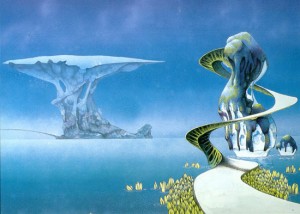Psi, the Enjoyment Body, and the Electric Power of Yes

Like many people, I am fascinated by synchronicities that occur in my life, and I even see them as signposts on my life’s path. Yet the “nuts and bolts” side of me agrees with Arthur Koestler in his wonderful 1972 survey of ESP research, The Roots of Coincidence: Carl Jung’s theory of synchronicity is a muddle, little more than a label slapped onto a mystery without really offering any illumination. In this, it is a bit like the 17th-Century concept of “phlogiston,” the postulated fire-like element that was proposed to cause substances to combust before scientists discovered oxidation reactions. Synchronicity seems like a placeholder concept, awaiting a better, more coherent story.
We have the power to create or nurture optimal conditions of our personal unfoldment and realization of our intentions; we simply need to take seriously the power of coincidence in our lives.
Several of my recent posts have attempted to offer a relatively simple mechanism for synchronicity, via psi. In a universe where information from the future can influence us, even just on an unconscious level, it must produce the kinds of complex impossible scenarios familiar from time-travel stories in science fiction, including both “grandfather paradoxes” and, occasionally, self-amplifying or self-confirmatory feedback loops resulting in truly uncanny-seeming coincidences. I’ve also suggested that the Lacanian concept of jouissance or “enjoyment” may be a kind of carrier of psi information through time—or at least may somehow mediate psi—and thus may provide a better language for talking about psi’s science-fictional effects than the Jungian language of synchronicity and archetypes.
 Still, there is an unmistakeable suggestiveness to the word “synchronicity” that is undoubtedly part of its appeal and staying power: Seemingly modeled on the word “electricity,” synchronicity implies a dynamism and some sort of energetic current. Jung clearly intuited that this thing, this acausal connecting principle, was less like the static sticky “cords” and other subtle connections described in the Theosophical and spiritualist literature of his day and more like a dynamic energy that moved and flowed among material configurations and mental forms, ideas, and symbols. It’s a thing in motion that, when touched, might shock you, and may be capable of short-circuiting; it may be capable of destroying you if you’re not careful. An archetype, as Jung described it, is like a battery for storing and releasing this energy.
Still, there is an unmistakeable suggestiveness to the word “synchronicity” that is undoubtedly part of its appeal and staying power: Seemingly modeled on the word “electricity,” synchronicity implies a dynamism and some sort of energetic current. Jung clearly intuited that this thing, this acausal connecting principle, was less like the static sticky “cords” and other subtle connections described in the Theosophical and spiritualist literature of his day and more like a dynamic energy that moved and flowed among material configurations and mental forms, ideas, and symbols. It’s a thing in motion that, when touched, might shock you, and may be capable of short-circuiting; it may be capable of destroying you if you’re not careful. An archetype, as Jung described it, is like a battery for storing and releasing this energy.
Whatever terminology we choose to adopt, the question that must ultimately motivate any research into the actual functioning of psi and coincidences would have to be: Can we weave it into our theories of how things happen enough that it could be predictive of events outside the laboratory? If treated in the right way, is it also capable of powering something? Can we harness this substance or this energy?
A Duh Experience
As I was finishing my recent post about my “eureka” that synchronicities are illusions created when personally significant but minor coincidences are unconsciously amplified through atemporal feedback loops, my eureka quickly degraded (as eurekas often do) to more of a “duh.” My basic idea was nothing that many practitioners of ritual or chaos magic, or for that matter many adherents of various positive-thinking philosophies, would disagree with, even if I was drawing on different metaphors. Essentially, we have the power to create or nurture optimal conditions of our personal unfoldment and realization of our intentions; we simply need to take seriously, if not fervently believe in, the power of coincidence (and, by extension, magic and meaning—or psi, as I prefer to call it) in our lives. It is exactly this orientation to coincidence that helps us boostrap our condition in a favorable direction.
Enjoyment is the most basic, amoral, childlike power of “yes,” which can even be thought of as extending both forward and backward through time like an atemporal power current in our lives, linking past and future into a timeless electric present.
A characteristic of synchronicity is that people often interpret it as a confirmation of being on the right track, following the right path, doing what they’re supposed to be doing—”God winking” is how one person put it to me recently. Even if synchronicities are really illusions based on failure to see that we live in a Phil-Dickian universe and that we ourselves are unconsciously creating these self-confirmatory circumstances, they’re nevertheless an indicator of a productive habit with high payoff: noticing, paying attention, being alert to the mysterious. One reason to shift from the vague and neutral language of “synchronicity” to terms of Lacanian psychoanalysis is that the latter idiom indicates just what it is we are really detecting when we notice a coincidence: We are detecting our enjoyment. Orienting to psi and coincidence is really an indirect but potentially powerful way of making enjoyment our life compass.
This is because it is precisely the giddy enjoyment of confirmation that is the “energy” at the heart of coincidences. The gratification that ensues when the objective world confirms our innermost beliefs, expectations, and wishes—even when there is a bad or even calamitous implication to the confirming event itself—can be picked up on in advance of the stimulating event. In the context of suffering-causing neuroses, Freud called these “secondary benefits,” but even though it is a kind of pretentious foreign word, I kind of like “jouissance” because it connotes an enjoyment that could be either euphoric or harmful, even deadly, depending on our attitude. Prophetic jouissance is our enjoyment at the uncanny, including our own seeming uncanny powers, even when they have directed our attention toward or anticipated something terrible.
 Enjoyment in this sense is the most basic, amoral, childlike power of “yes,” which can even be thought of as extending both forward and backward through time like an atemporal power current in our lives, linking past and future into a timeless electric present.
Enjoyment in this sense is the most basic, amoral, childlike power of “yes,” which can even be thought of as extending both forward and backward through time like an atemporal power current in our lives, linking past and future into a timeless electric present.
“Follow your bliss” was how the Jungian mythologist Joseph Campbell famously phrased his prescription for the good life, and as a philosophy of life or life principle there is probably none better or more universal. “Bliss” is just the ancient Anglo-Saxon word for enjoyment (bliðs); Campbell’s recommendation could be understood as an ironclad law if we understand enjoyment in its psychoanalytic meaning, as something we are always following but that actually causes us pain when we are living in a state of ignorance about what it is we truly enjoy and how we are getting our enjoyment secretly.
Thus Campbell could really have said: Know what your bliss is, because you can’t help but follow it. And there, he’d be right in line with any psychoanalyst, Freudian or Lacanian, not to mention the Buddha (overcome ignorance), or pretty much any philosopher in the West (know thyself). Knowledge over ignorance is hard to question as a recipe for health and happiness. Because it is really unavoidable, bliss has a circular quality, and when we try to translate it into linear and logical terms, it produces the tricksterish and sci-fi effects that arise in a world that resolutely only believes in linear causality.
Turtles All the Way Down
I have often dimly noticed that the truest statements seem to have a fractal, recursive, self-similar quality: They are like the Indian story of the world resting on the back of the turtle, which rests on the back of another turtle, and it is turtles all the way down. Logicians and psychologists hate such things: Infinite regress and its variant, circular reasoning—that is, self-confirmation—are the very definition of error and fallacy. But self-confirmation is really the scandalous secret at the heart of language. Linguistic meaning can only ever rest, ultimately, on empty, circular, self-reference.
Bliss has a circular quality, so when we try to translate it into linear and logical terms, it produces the tricksterish and sci-fi effects that arise in a world that resolutely only believes in linear causality.
This was Lacan’s great insight about the Symbolic register which entraps us as humans and causes all our neurotic suffering: The only thing that pins arbitrary symbols in place is the gaping holes in that structure, the empty signifiers like proper names (e.g., “the Name of the Father”) and empty ideological constructs (e.g., “freedom”). These holes structure the slippery maze of more mundane signs, the same way supermassive black holes provide the structure to a galaxy: Without these empty or self-circular terms, language would be a slippy-slidey indeterminate nonsense soup. The only “really real” is outside of symbols and language altogether. For this reason, the truest statements—really, the only true statements—are those that are circular or otherwise nonsensical, that have no traction within the symbolic but eject us out of the symbolic into the Real, which is the domain of enjoyment/bliss.
Paranormal phenomena including psi and precognition have precisely this symbolically traction-less, illogical, circular—and I would argue, covertly blissful—quality. If and when we acknowledge their reality (despite their resolute illogic), then it gives circularity a new kind of force and truth. It is precisely our own entrainment to psi-confirmatory events (coincidences) through making a habit of noticing and perhaps commemorating them which causes our actions and our lives to assume a more meaningful, archetypal shape—a sort of positive version of what Lacanian psychoanalysis (which generally deals with dysfunction) calls a “symptom.” In other words, through a circular and self-fulfilling logic, not only belief in but also enjoyment of coincidence enables us to harness, or is a prerequisite for harnessing, our unconscious psi capacities for our benefit.
 As some kind of atemporal, nonlocal constant in our lives, I’m almost tempted to call this self-confirmatory power of agreement the “enjoyment body” or sambhogakaya described in Buddhist philosophy (part of the trinity that includes the dharmakaya or “essence body” and the nirmankaya or physical form-body). It is like our atemporal being, our “long body,” like the world-line of Minkowskian physics except the continuity is not that of the particles of our physical form but of the nonlocal and unchanging substanceless substance of our bliss, a sort of resonating string extending across our lifespan (and beyond?). It is something we may be only dimly conscious of, and there is always some level of it that remains hidden from view and monstrous, because it is partly beyond morality and takes pleasure even in horror.
As some kind of atemporal, nonlocal constant in our lives, I’m almost tempted to call this self-confirmatory power of agreement the “enjoyment body” or sambhogakaya described in Buddhist philosophy (part of the trinity that includes the dharmakaya or “essence body” and the nirmankaya or physical form-body). It is like our atemporal being, our “long body,” like the world-line of Minkowskian physics except the continuity is not that of the particles of our physical form but of the nonlocal and unchanging substanceless substance of our bliss, a sort of resonating string extending across our lifespan (and beyond?). It is something we may be only dimly conscious of, and there is always some level of it that remains hidden from view and monstrous, because it is partly beyond morality and takes pleasure even in horror.
I remember watching an interview years ago with a sufferer of temporal lobe epilepsy, which gave me some insight into the potential negative dimension of mysticism and why bliss in the face of tragedy is experienced as pain. Temporal lobe seizures sound appealing at first blush, because they effectively are ‘religious’ experiences in which everything is suffused with bliss and an overwhelming sense of rightness—an ecstatic agreement with the universe. But such a feeling can quickly become excessive and oppressive: The patient noted that even horrific events like the Holocaust had that same feeling of ‘blissful rightness’ when he was in the throes of a seizure. If the deeper foundation of the universe is a kind of nondual bliss-rightness, and this is the current that psi taps into, then it is easy to see why normal human cortical functioning may act as a powerful reducing valve on this kind experience. For social creatures, an amoral sense of rightness even in extreme human suffering just cannot be workable; this may account for why psi sometimes feels like playing with dangerous cosmic forces.
9/11, for instance, fulfilled unconscious calamitous wishes even as it horrified us, and consequently it set the bliss current, the enjoyment-body, vibrating in a very particular way, stimulating premonitory dreams beforehand and even, perhaps, inspiring many of the artworks that uncannily ‘foretold’ the event. If it takes deaths and tragedies to make us aware of our larger nonlocal self, do we really want that? Well, some amoral unconscious part of us would say “yes.” That’s the problem, and fascination, of psi.
Tricksters and Meaning
The healthy middle ground, of course, is neither pathological immersion in bliss nor complete ignorance or separation from it, but knowing where it is and being able to draw from it intermittently, as needed. Such is the aim of mystical schools like Zen and other schools of Buddhism (the “middle way”), which aim to put one firmly in contact with the ground of bliss-awareness without being swamped by it.
If it takes deaths and tragedies to make us aware of our larger nonlocal self, do we really want that? Well, some amoral unconscious part of us would say “yes.” That’s the problem, and fascination, of psi.
In its own way, the ideal of health formulated by the later Lacan was not unlike this; he said we need to learn to “enjoy our symptom,” our furtive secret system through which we extract a forbidden extra something that gives meaning to our lives. Because of its dark dimensions, that extra something, that enjoyment, is always somewhat alien, somewhat beyond both pleasure and understanding … but there are different degrees of unknowing. Those who really suffer are those who are in total ignorance about the nature of their bliss, and thus it destroys them. At the very least it may be experienced as a tricksterish fate that constantly reaches in and mocks and parodies their aspirations, undercuts and sabotages their plans, thwarts them in their lives and hopes.
This seems to be the experience of therapists when confronted with some patients who seem to have devious and completely unconscious ways of eliciting punishment and suffering from their universe. For example, the neurotic trapped in a repetitive or obsessive symptom is deriving enjoyment but in a way that is hidden even from him/herself, and thus life for that person may seem like a constant car wreck. Enjoyment isn’t the same as pleasure; we can go without mere pleasure, and many cultures and religions (such as the Calvinism of my own Pennsylvania Dutch ancestors) make a big deal of draining life of as much hedonic gratification as possible, but that’s not the same thing as enjoyment. Even within the denial of the body and its pleasures, enjoyment can be extracted, a kind of furtive Promethean theft of what is truly the fire of life. Without that—without the ability to enjoy in some furtive secret way—then life is not worth living. Enjoyment is another way of saying “the meaning of life,” and people who commit suicide are those who cannot find a way of enjoying, which is another way of saying their life has lost its meaning.
 So, precisely here, the Lacanian notion of enjoyment touches this fundamental thing that is at the core of synchronicity: meaning. When we say a coincidence is meaningful, we don’t mean that in the workaday sense that a word or a symbol has meaning, that it has a dictionary definition or that it can be decoded or put into words at all; we mean it in a larger, existential way—it connects with the secret sustaining substance of our life, our bliss, our atemporal “enjoyment body.” The best synchronicities often read like a confirmation that we are following our bliss in an awake, aware, healthy way. The worst ones—and there seem to be plenty of those—seem like wake-up calls that we are not facing some dark dimension of our enjoyment.
So, precisely here, the Lacanian notion of enjoyment touches this fundamental thing that is at the core of synchronicity: meaning. When we say a coincidence is meaningful, we don’t mean that in the workaday sense that a word or a symbol has meaning, that it has a dictionary definition or that it can be decoded or put into words at all; we mean it in a larger, existential way—it connects with the secret sustaining substance of our life, our bliss, our atemporal “enjoyment body.” The best synchronicities often read like a confirmation that we are following our bliss in an awake, aware, healthy way. The worst ones—and there seem to be plenty of those—seem like wake-up calls that we are not facing some dark dimension of our enjoyment.
Ac-centuate the Positive
Because our tacit precognitive capacity entrains our attention (our noticing) to random coincidences that happen to confirm our desires, expectations, and beliefs, we unknowingly participate in cultivating a universe that conforms to our intentions, and thus the world assumes an increasingly uncannily (or, gratifyingly) familiar and even magical quality—it becomes a more enclosed and secure universe, in some ways similar to the universe of childhood. This of course is one of the criticisms leveled by skeptics: that belief in the paranormal is a reversion to childishness. Because there is no living, respectable contemplative tradition in the rationalist West, mysticism is viewed similarly, even by psychoanalysts, who have seldom been able to see mystical experience other than as infantile regression.
We unknowingly participate in cultivating a universe that conforms to our intentions, and thus the world assumes an increasingly uncannily (or, gratifyingly) familiar and even magical quality.
In his monumental book, First Sight, James Carpenter quotes Jung: “How does it come that even inanimate objects are capable of behaving as if they were acquainted with my thoughts?” Psi, Carpenter argues, arises in that unconscious (you might also say child-like) domain where there is no separation between self and other or between self and objects, and where perception and action merge. I would add that it is the world of what child psychoanalyst D.W. Winnicott called “transitional phenomena,” similar to the “liminal” phenomena described by George Hansen in his also monumental book The Trickster and the Paranormal
. You could say that psi is a natural entailment of the underlying nondual nature of things that mystics have always asserted but that we are unable to consciously experience except in moments of grace or ego-less, wordless rapture, because of the “reducing valve” function of the cortex. This would fit well with the writings of Patanjali on the siddhis, for example, as well as the modern ‘tradition’ of linking ESP to mystical practices like yoga or Tantra (see below). When mystics dive down in meditation, a pure ocean of undifferentiated bliss-awareness is what they often describe.
If our enjoyment is indeed a kind of atemporal acausal connecting principle acting as a magnetic field polarizing our actions and thoughts at all times, then in trying to gain some greater insight into when and how synchronous (and, I’d wager, other paranormal) events happen in our lives, we should pay attention specifically to our enjoyment, not merely our thoughts. Indeed our thoughts, which yogis and Buddhists have always likened to waves in the sea of mind, seem like transient effects or epiphenomena on the surface of enjoyment, formations built out of that more basic and oceanic raw material like the fleeting architectural and mimetic forms generated on the sea of Solaris.
 I think enjoyment may be a truer label for the nonlocal substrate of existence—even material existence—that many antimaterialists nowadays seek using the idiom of “consciousness.” If we adopted the idiom of “jouissance” or “enjoyment” or “bliss” it might open up new ways of thinking about matter in relation to mind, as well as clarifying seemingly unrelated problems like those of artificial intelligence and the nature of sentience. For instance, people talk about computers becoming conscious, but this seems like a canard; the real question is, could they enjoy? (I strongly think, no.)
I think enjoyment may be a truer label for the nonlocal substrate of existence—even material existence—that many antimaterialists nowadays seek using the idiom of “consciousness.” If we adopted the idiom of “jouissance” or “enjoyment” or “bliss” it might open up new ways of thinking about matter in relation to mind, as well as clarifying seemingly unrelated problems like those of artificial intelligence and the nature of sentience. For instance, people talk about computers becoming conscious, but this seems like a canard; the real question is, could they enjoy? (I strongly think, no.)
I also think it is directly relevant that there is a long tradition—what could be called a kind of alt-spiritual or New Age consensus—that positive thinking has a magnetic power or force over health, wealth, etc. This is of course the famous “secret” or “law of attraction” that has been popularized in countless self-help books and that is one of the core ideas examined in Mitch Horowitz’s excellent history, One Simple Idea. Positive thinking is not exactly or necessarily the same thing as enjoyment, but knowing enjoyment—the blissful as opposed to the ignorant, neurotic, resistant, painful kind—seems closely allied to positive thinking. If positive thinking really has some kind of attractive force in the world, some influence that spills over from mind to matter, you might say, then being in touch with our enjoyment would account for it, maybe precisely via the ‘science-fictional’ effects (e.g., atemporal feedback loops or “attractors”) I described.
Shifting from Jung’s language of synchronicity to Lacan’s language of enjoyment enables us to formulate other interesting hypotheses about psi and coincidence that could potentially be tested. For example, it would be an empirical question: Are positive synchronous or paranormal events experienced more by mentally healthy, relatively less neurotic people who are more in touch with their enjoyment? Are tricksterish ones experienced more by neurotics? I don’t know if synchronicity per se has been studied experimentally or how you would go about doing that, but Carpenter cites evidence that the traits of extroversion and optimism are strongly associated with high performance on tests of psi. This makes sense of why gregarious, confident, attention-seeking personalities—for instance folks like Uri Geller or, according to remote-viewing pioneer Russell Targ, Italian women—tend to do well at psi tasks.
Synchronicity and Kundalini
Another reason why rephrasing the concept of synchronicity in Lacanian terms might be an advance is that notions like “bliss” and “enjoyment” are closer to the literally or metaphorically sexualized energies that have in one way or another been linked, both in the West and East, to paranormal experiences and, more broadly, to human potentiality.
 Jouissance in French connotes an orgasm so extreme it is actually agonizing. The maverick Freudian psychoanalyst Wilhelm Reich famously theorized the orgasmic nature of the chi-like energy linking us to the universe and called it “orgone.” Reich’s orgone theory closely resembles other ideas that have emerged again and again in spiritualism and occultism, such as the “odic force,” Mesmer’s “animal magnetism,” Bergson’s “elan vital,” the “mana” of pseudo-Hawaiian shamanism, and in Russia, Nikolai Kozyrev’s “torsional energy field.”
Jouissance in French connotes an orgasm so extreme it is actually agonizing. The maverick Freudian psychoanalyst Wilhelm Reich famously theorized the orgasmic nature of the chi-like energy linking us to the universe and called it “orgone.” Reich’s orgone theory closely resembles other ideas that have emerged again and again in spiritualism and occultism, such as the “odic force,” Mesmer’s “animal magnetism,” Bergson’s “elan vital,” the “mana” of pseudo-Hawaiian shamanism, and in Russia, Nikolai Kozyrev’s “torsional energy field.”
Psychical researchers have always noticed a connection between psychic and paranormal phenomena and sexual development and arousal, frustration of sexual expression, etc. Poltergeists are associated with puberty, for example; remote viewing has been associated with sexual desire by some writers, such as Ingo Swann. The Western sex magic tradition links psychic effects to sex (e.g., chaos magicians often use the orgasm as a portal to the unconscious for the purpose of controlling fate through sigils; the “kalas” in the Typhonian tradition of ritual magic developed by Kenneth Grant are essences of female sexual lubricants produced through arousal; and so on). And most centrally, some Tantric traditions see the fundamental organizing energy of the universe as related to the body and its pleasures, in the form of Kundalini.
The Freudian-sexual framework with its concepts of “libido” and “sublimation” is in some sense just a clunky and very partial theory of this sexual psychic-cosmic energy: Kundalini is the libido extended to the full bodymind, a framework enabling us to see the value of this energy beyond mere reproduction and social dominance concerns (and art) and see how the mystical and even the psychic may draw from the same spring. (According to Jeffrey Kripal, the Bhagwan Rashneesh once quipped that “Freud only got to the third chakra.”) Kundalini might even be thought of as another term for jouissance, although one with its own particular cultural baggage and symbolism and its own particular blind spots. That this energy is believed to ordinarily slumber at the base of the spine could be in part a figurative understanding of the fact that most people are mainly conscious of their survival and sexual concerns and remain relatively ignorant of their “higher” priorities and the more obscure (and sublime) ways they derive enjoyment.
 What we can usefully take from the vertical Tantric schema of Kundalini as a spectrum related to or at least symbolized by the hierarchy of chakras is (at the very least) that there’s a continuum structuring the relationship between the various aspects of the human bodymind and the broader acausal context, and thus that this substance-energy, whatever we choose to call it, might be converted or transmuted or changed in wavelength—all the way from the organismic and the orgasmic “up” to the creative, intellectual, and spiritual. This “transmutation” is intrinsic to the definition of Tantra, as well as to the “inner” traditions of alchemy both in Asia and Europe.
What we can usefully take from the vertical Tantric schema of Kundalini as a spectrum related to or at least symbolized by the hierarchy of chakras is (at the very least) that there’s a continuum structuring the relationship between the various aspects of the human bodymind and the broader acausal context, and thus that this substance-energy, whatever we choose to call it, might be converted or transmuted or changed in wavelength—all the way from the organismic and the orgasmic “up” to the creative, intellectual, and spiritual. This “transmutation” is intrinsic to the definition of Tantra, as well as to the “inner” traditions of alchemy both in Asia and Europe.
Other mystical models start instead from the top and work down, privileging cosmic or heavenly energies or awareness or gnosis and deriving “lower” forms from them. One could include the Western Hermetic tradition here, as well as the “higher Tantras” of Asia, including Dzogchen, which privileges an oceanic Void of pure bliss-awareness and is, according to Targ, the royal road to developing ESP abilities. (If that’s the case, Zen, which is nearly identical to Dzogchen in its privileging of the unborn Void, bypassing ’transmutation’ of baser energies in favor of self-extinction of ignorance and desire, should be equally useful.)
Inner Conspiracies and Paranormal Enjoyment
In any case, and through whatever symbolic language or practice we adopt, the theory I’m putting forward suggests the way to move forward in a science fictional universe is to get clear about our enjoyment: What are we enjoying, and how?
Include the knower in the known by including the enjoyer in the enjoyed: What secret benefit or bliss do you get from your particular surreptitious bargain with reality?
Note, this is a very different question from that of desire—i.e. what do you want, which tends to be the focus of most therapy and even of much magical practice in the form of intention-setting. Desire and want point to lack, which is the underpinning of our insecurity and the motor of our forward motion in life. But even in our lack, even in the midst of our deprivation, we are enjoying. We enjoy our desires and our states of lack in very obscure ways, and thus cutting through desire to enjoyment is the key. In other words, include the knower in the known by including the enjoyer in the enjoyed: What secret benefit or bliss do you get from your particular surreptitious bargain with reality? What in you does your symptom serve, and why? Examine your secret sources of enjoyment, and then come clean about it, if only to yourself.
This kind of enjoyment-examination is perilous. Psychoanalysis lasts so long because the analyst is perceived as trying to steal away the patient’s secret enjoyment, so years and years of resistance have to be overcome through attrition and trickery, like a shamanic cure but in slow expensive motion. It seems to me that private self-examination in meditation should be a much more direct and fruitful approach than this kind of frontal assault, because all it requires is self-honesty: You can keep your enjoyment a secret, in the end.
Enjoyment-examination (or perhaps, bliss-analysis) has direct and special relevance to those of us with an interest in psi and other liminal, paranormal topics, and who ‘want to believe.’ If you are honest with yourself, you may find you are in a very weird and precarious position with your enjoyment of this subject matter. What do you enjoy believing, and why do you enjoy believing it? Why do you enjoy believing in ESP, and what would happen if suddenly everybody else believed in it too? What secret benefit to you get from your time spent reading or discussing the topic of UFOs? What would happen if tomorrow there was some public and unmistakeable confirmation of their reality, and a confirmation that they were _______ (fill in the blank: ETs, tulpas, interdimensional beings, or whatever turns your crank)? Would that change how you relate to the subject?
Our enjoyments in this sense are what in a psychoanalytic idiom are called our “unconscious investments.” As in the study of political-economic formations and conspiracies like Watergate, where you “follow the money,” in understanding ourselves—and the nature of psi, and UFOs, and consciousness, and all the rest—we need to follow the bliss. The quagmire of complex unconscious investments in the paranormal fields may account for many of the tricksterish effects described by Hansen … but this is the subject for a later post.

 hubris, this is context for the following comment:
hubris, this is context for the following comment:



“I think enjoyment may be a truer label for the nonlocal substrate of existence—even material existence—that many antimaterialists nowadays seek using the idiom of ‘consciousness’.”
This feels very appealing and satisfactory. Brings to mind a line from Gibran: “life’s longing for itself….”